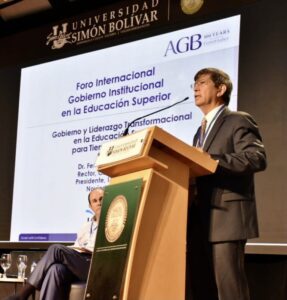In his final three months as head of the International Association of University Presidents, Fernando León García notices a troubling trend brewing. Despite members’ commitment to globalizing education and eradicating inequity, colleges and universities are slowly reverting to old habits.
“We seem to be going back to our little cubbyholes and becoming more insular,” says León García, who is also the president of CETYS University in Baja California, Mexico. “It’s disappointing and wrong.”
The association’s 2021 report surrounding institutional responses to the pandemic garnered feedback from 801 respondents across 92 countries. Its 2024 report reflecting post-pandemic era initiatives only mustered 60 responses.
What does this regression look like on home soil?
The pandemic spurred higher education leaders worldwide to reexamine their programs’ commitment to workforce-ready skills, create nimbler strategic initiatives and upgrade their digital infrastructure, León García says. Perhaps the most important silver lining was their heightened sense to “build bridges across borders” through communication, coordination and outreach. “There was a growing sense of empathy and solidarity. We became aware that we couldn’t do most things alone.”
León García made a concerted effort to diversify the association’s executive committee membership by including more women and expanding its membership of higher education organizations across the globe. The world’s top-ranked colleges and universities saw a similar trend emerge following an uptick in women-led institutions in 2023. Not only did the U.S. lead this movement, but it also quickly scaled up DEI initiatives to welcome and support first-generation and minority-background students.

Over the last year, however, U.S. higher education has seen several statewide efforts to ban DEI initiatives succeed. Furthermore, the Supreme Court’s ruling last year to end affirmative action has disintegrated several race-based scholarship and internship programs aimed at improving Black student success metrics across Missouri, Texas and Duke University, among others.
The association also concluded in its 2024 report that spurring international partnerships—through collaborative research, joint academic programs and faculty exchanges—could “bolster the global standing and academic prestige of institutions.” While some U.S. institutions are finding innovative ways to collaborate with overseas partners, heightened tensions with China may erase some of these advancements.
More from UB: Why proving program ROI is higher ed’s latest challenge
“I do not believe the environment is as hospitable for educational exchange as it was in the past, and I think both sides are going to need to take steps,” Deputy Secretary of State Kurt Campbell told AP News following plummeting U.S. study abroad trips in 2023.
A recent investigation by a Republican-controlled House subcommittee into university research it claimed was aiding China’s military represents the latest move from Congress to heighten oversight of U.S.-China research partnerships.
All of these developments may be partially contributing to U.S. higher education’s record decline in reputation regarding its teaching and research in Times Higher Education‘s latest world university rankings.

“If you’re not open to at least understanding what is happening and having a conversation about this with the university community and the professoriate, you might be doing a disservice to your institution,” León García says. “As a leader, you have to have this conversation and bring it to the forefront.”
Other global higher education trends impacting the U.S.
The pandemic provided U.S. higher education a “rude awakening” regarding its own relevancy, León García says. Here are a few ways institutions can stay current:
- Leveraging technology to create student-centered pedagogy: Hybrid learning modalities and the further development of smart campuses will help institutions stay nimble and reflexive to students’ rapidly changing personal lives.
- Faculty/professional development: Institutions embracing the digital age must put the same amount of investment in their faculty to upgrade their technological skills. Faculty lacking institutional guidance surrounding edtech adoption are more prone to suffer from low work morale.
- Expanding workplace-centered skillsets: “You have to be developing good citizenry, but you also need to make sure that the skills that they’re developing help them become employment-ready,” León García says.
- Increase student support measures: “Post-pandemic, we need leaders to recognize and beef up ‘hand-holding’ so that students not only enroll but receive the appropriate support, orientation and follow-up needed for them to be successful,” León García says.
- Pursuing long-term financial sustainability by optimizing mission-driven, programmatic offerings: “To what extent are you being strategic, not trying to do everything for everyone, [and focusing on things] you are able to do right?” León García says.
With leadership built around three-year blocks at the International Association of University Presidents, León García will conclude his term at the end of 2024 before the role transitions to Shawn Chen, founder and chairman of Sias University in Zhengzhou, China.

